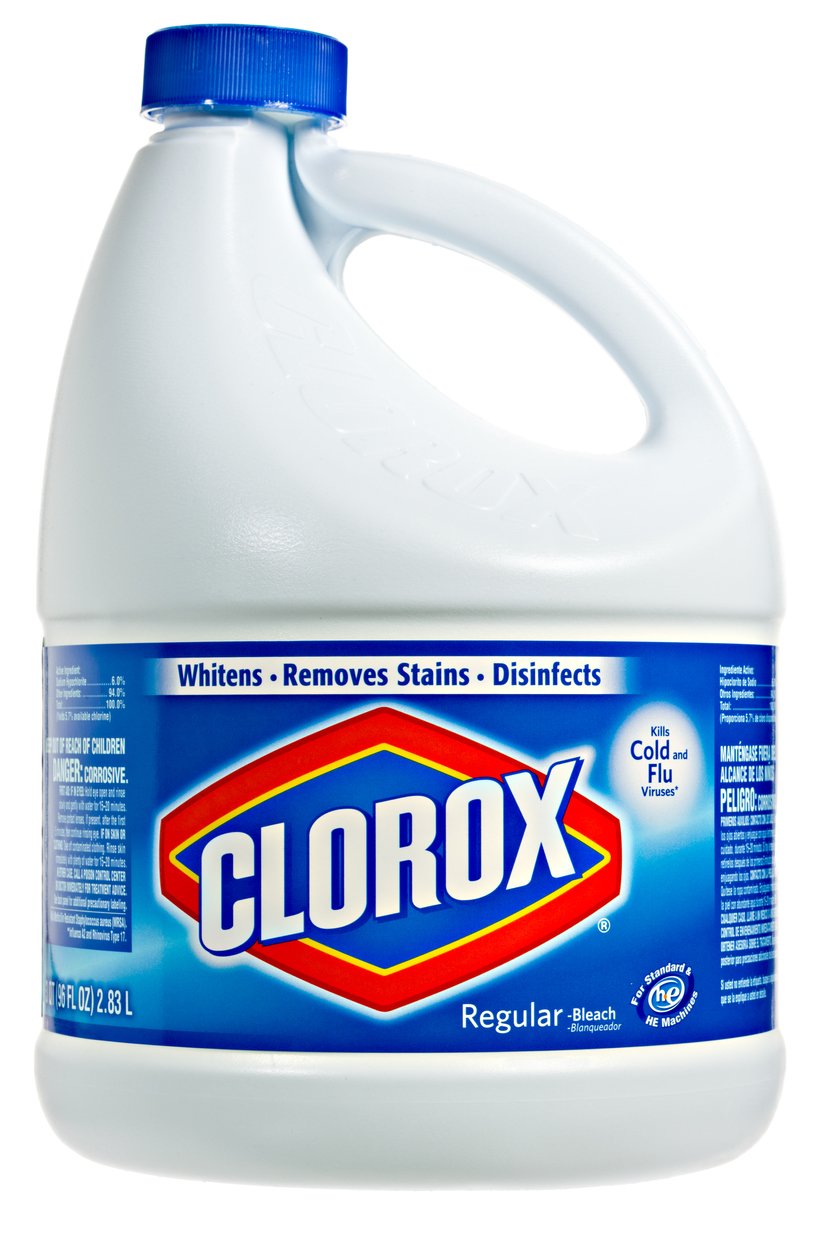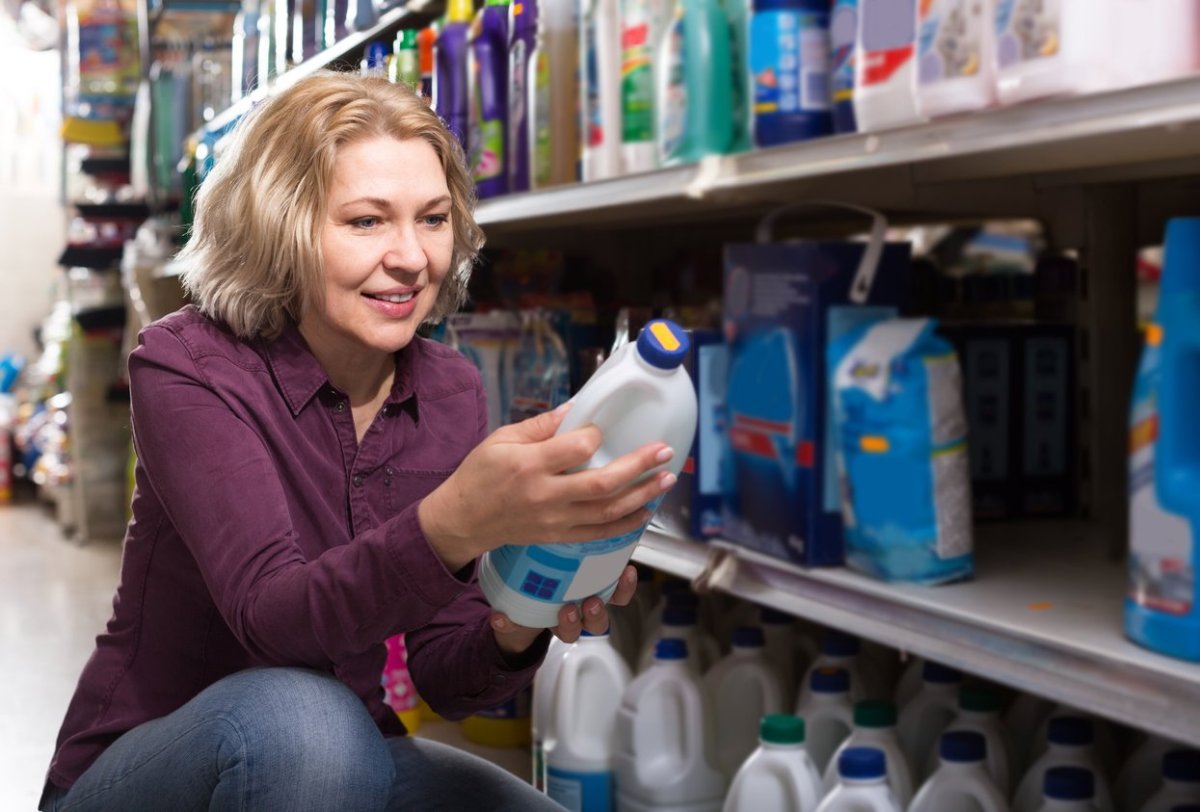We may earn revenue from the products available on this page and participate in affiliate programs. Learn More ›
Q: I like to use a bleach mixture to clean and disinfect around my home, but lately I’ve noticed the unused portion in my bottle doesn’t have the same strong smell. I’ve had the same large jug for a few years, and though I always make sure to close the cap after use, I’m wondering if the bleach has lost its efficacy. Does bleach expire? And, if so, how long is its shelf life?
A: Though often sold in large containers that might lead you to believe it can last forever, bleach—a sodium hypochlorite solution—does expire over time, eventually degrading into plain old saltwater.
The shelf life of bleach is approximately six months, but proper storage can help it last a full year before its effectiveness begins to drop by 20 percent yearly.
What’s more, any mixture of bleach and water—which most people use around the house for cleaning—will dramatically reduce the shelf life of the solution. An effective disinfectant solution of bleach and water at a 1:4 ratio will last for approximately one week before the active ingredients begin to break down.

Temperature, light, and contaminants can shorten the shelf life of bleach.
While there is some discrepancy about whether bleach is environmentally friendly or not, its main components do begin to break down in a relatively short period of time. When you first purchase a bottle of bleach, the concentration of its active ingredient, sodium hypochlorite, is about six percent. Extreme temperature (significantly above or below 70 degrees Fahrenheit) and contamination from other products, such as oil, paint, or any other product that may be stored in the same location, can greatly increase the speed at which bleach breaks down. Degradation can also be increased by exposure to light, which is why bleach is sold in an opaque bottle. To maximize the shelf life bleach, store it in a dark, room-temperature area.
Decode the listed expiration date.
It’s best to finish a bottle of bleach before its six-month expiration—but you’ll have to do a bit of sleuthing to figure out when that is! Bleach manufacturers do not list an expiration or “best by” date on the bottle; instead, they use a more specific manufacture date that lists the exact day the bleach solution was produced to ensure that only viable product is shipped to retailers. If you examine the bottle, you’ll see two lines of code. The first line indicates the type of product, the production plant, and the date of production. The second line is an environmental protection agency (EPA) registration code, followed by a state identification code.
To determine the expiration of a bottle of bleach, look at the first line of code, for instance: A92010007. A9 refers to the plant that manufactured this particular bottle 20 represents 2020, and 100 is the 100th day of 2020 (April 10th). The final two numbers, 07, are simply a manufacturing shift identification code. Given that bleach expires after about six months, use basic math to determine that this bottle will expire on October 10th, 2020.

When bleach breaks down, it becomes less hazardous.
The sodium hypochlorite in household bleach is effective at stain removal and disinfecting. But bleach also contains sodium chloride (salt) as a thickening and stabilizing agent, sodium carbonate (washing soda) as a cleaning agent for alcohol and grease, sodium hydroxide (lye) as another cleaning agent for fatty and oily stains, and sodium polyacrylate to prevent dirt and grime from reattaching to fabrics during a wash cycle.
After the six-month expiration date, the sodium hypochlorite in bleach begins to degrade, at a rate of about 20 percent per year. Ultimately, due to the reaction of unstable ions, sodium hypochlorite (3NaOCl) breaks down into salt (2NaCl) and sodium chlorate (NaClO3), which is soluble in water. Bleach then becomes simple salt and water with no free chlorine molecules, meaning that there is no risk of chlorine gas being produced unless it is mixed with an acid or ammonia. Clorox estimates that their product breaks down to about 95 percent to 98 percent salt and water, with any remaining sodium hypochlorite or other ingredients breaking down rapidly into compounds that can be handled by a septic system or sewage treatment plant.
It’s unwise to use hazardous chemicals such as pesticides and aerosol paint after their recommended usage period or expiration date because the chemicals and containers may have degraded, resulting in dangerous fumes or fire risks. Yet, while sodium hypochlorite can be toxic if ingested and can cause skin and ocular burns if it comes into contact with your skin or eyes, once bleach degrades to saltwater it becomes a less dangerous product. That said, bleach at any stage must be stored carefully away from children and pets.
Don’t rely on expired bleach to clean well or kill germs.
The longer bleach sits around, the less effective it is at cleaning and disinfecting. While the product can still be used as a cleaning agent past its expiration date, results will vary greatly depending on storage, the exact date of manufacture, and exposure to light. Furthermore, it is not recommended that expired bleach be used as a disinfectant because the exact percentage of sodium hypochlorite cannot be measured accurately, indicating that your solution may or may not be effective at killing bacteria, viruses, or fungi.
RELATED: 8 Cleaning Mistakes Everyone Makes
Dispose of expired bleach safely.
Even if bleach is expired and no longer effective, it must still be disposed of properly because it has been designed to break down fully in septic and sewer systems. Without proper disposal, ingredients in bleach may remain active, causing environmental damage. The disposal of bleach is regulated by the federal government and must follow certain guidelines. A bottle that contains less than five gallons of bleach can be poured into the sink or flushed down the toilet as long as your home is connected to a municipal sewer system; be sure to run water in the sink to help degrade remaining sodium hypochlorite quickly. If you have more than five gallons of bleach to get rid of, or if your home is not connected to a municipal sewer system, you must contact a waste disposal company. The disposal company will either come to your home for significant quantities or have you drop off the bleach at their facility for disposal.


